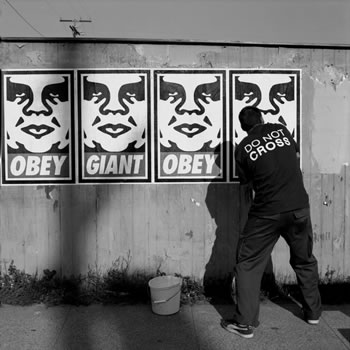I will be making a case for the development of a Visual Phenomenological Methodology within Visual Communication later in this paper. But before I do I wish to explore phenomenology’s existing connections. Phenomenology as a philosophical and a qualitative research methodology have yet to truly be adapted within a Visual Communication context. Design journalist Rick Poynor points out that the discipline “has long had an aversion to theory” (Poynor, 2003, p10).
This is no wonder because as young discipline Visual Communication does not have “a couple of centuries’ worth” of academic design literature (Rock and Poynor, 1995) that other disciplines may have. From the existing literature it does have the word phenomena is widely used (Heller & Ballance, 2001; Margolin & Buchanan, 1996; Williams & Newton, 2007; Huck et al, 1997; Hill & Helmers, 2004; Barry, 1997) to describe the internal and external characteristics of graphic outcomes or in pictorial representation. Kenney in his essay on Representation Theory in The Handbook of Visual Communication (2005, p112) discusses image representation through lenses of semiotics, rhetoric and phenomenology, concluding that a theoretical synthesis would be a useful model for understanding image representations.
In Kenney’s later book on Visual Communication Research Designs (2009) it features examples of qualitative research methodologies available to visual communicators such as ethnography, discourse analysis and content analysis. But still nothing on synthesising phenomenology into a useful methodology despite the liberal use of the term ‘phenomena’. At this point a brief review of phenomenology within a Visual Communication context would be beneficial. To begin this I will discuss Shepard Fairey’s “Obey The Giant” sticker campaign called by himself as an “experiment in Phenomenology” (Fairey, 1990).
The Obey The Giant sticker campaign began in 1989 and is still an active piece of Visual Communication as a meme and subversive street art. Using a reductively stylised stencil cut illustration of the deceased wrestler Andre the Giant (see fig. 1) stickers, posters and sprayed images have spread across cities in North America into the western world. The image of Andre’s face hypnotically stares straight out and solely features the command “obey”. Obey The Giant was originally an undergraduate illustration project initiated by Shepard Fairey. In 1990 he wrote a manifesto behind the sticker campaign in which he “attempts to stimulate curiosity and bring people to question both the sticker and their relationship with their surroundings” (Fairey, 1990).

(Fig. 1 - Shepard Fairey and Obey The Giant (poster variant). Photo: Elizabeth Daniels)
The underlying tension of the campaign is the ambiguous nature of the relationship between image and text and it’s interpretation. Without Fairey’s context the sticker has been both embraced and rejected by people in the environments it is seen. A cultivated sense of a cultish communication is intrinsically linked to the phenomenon. In a later interview (undated, but at least post-1997) Fairey admits that Obey was “about creating an individual dialogue process that can expand into people trying to interpret it, and asking someone else, and then there’s two people talking about it. Something just going on that people can’t pigeonhole along with everything else” (Goodfellow, N.D.).
When journalists and commentators discuss Fairey’s Obey campaign they usually lead with the first line of his manifesto “The OBEY sticker campaign can be explained as an experiment in Phenomenology” (Fairey, 1990). Fairey briefly contextualises this statement with a brief explanation of phenomenology from a Heideggerian perspective. But this framing of the Obey campaign as a phenomenological experiment is very weak. He himself admits in interview with Goodfellow that he wrote it to satisfy college-educated people who “want you to empirically break down what it is, what it’s doing, and why. So I wrote the explanation for those intellectual Doubting Thomases, who’ve got to stick their finger in the hole” (Goodfellow, N.D.).
Fairey’s manifesto (Fairey, 1990) makes a clear statement that Obey is meant to stimulate curiosity and questioning of both the image itself and the image in the context of its surroundings. To achieve this he claims that the “first aim of phenomenology is to reawaken a sense of wonder about one’s environment”. Citing Heidegger, Fairey’s definition of phenomenology is weakly understood, “Phenomenology attempts to enable people to see clearly something that is right before their eyes but obscured; things that are so taken for granted that they are muted by abstract observation” (ibid.). As an example of Visual Communication it is a very strong project as an exercise in creating debate over meaning and interpretation. But as an example of Visual Communication using phenomenological theory and practice, it is a misnomer.
(To be cont.)
References
BARRY, A.M. (1997) Visual Intelligence: Perception, Image and Manipulation in Visual Communication. New York: State University of New York Press.
FAIREY, S. (1990) Manifesto – Obey Giant [online]. [Accessed 20 September 2011]. Available from: http://obeygiant.com/about
GOODFELLOW, C. (N.D) Andre The Giant Is Watching You [online]. [Accessed 27 September 2011]. Available from: http://obeygiant.com/articles/andre-the-giant-is-watching-you
HELLER, S. and BALLANCE, G. (2001) Graphic Design History. Allworth Communications.
HILL, C.A. and HELMERS, M.H. (2004) Defining Visual Rhetorics. Routledge.
HUCK, F.O., FALES, C.L. and RAHMAN, Z. (1997) Visual Communication: An Information Theory Approach. Springer.
KENNEY, K. (2005) Representation Theory. In K.S. SMITH, S. MORIARTY, K. KENNEY, and G. BARBATSIS (eds) Handbook of Visual Communication: Theory, Methods, and Media. Routledge. pp99-115
KENNEY, K. (2009). Visual Communication Research Designs. New York: Routledge.
MARGOLIN, V. and BUCHANAN, R. (1996) The Idea of Design. MIT Press.
POYNOR, R. ed. (2003) No More Rules: Graphic Design and Postmodernism. London: Laurence King Publishing Ltd.
ROCK, M. and POYNOR, R. (1995) What Is This Thing Called Graphic Design Criticism? Eye. 4 (16) pp56-59
WILLIAMS, R and NEWTON, J.H. (2007) Visual Communication: Integrating Media, Art and Science. Routledge.
Images:
DANIELS, E. (N.D.) Shepard Fairey [online]. [Accessed 27 September 2011]. Available from:http://www.elizabethdanielsphotography.com/#/89542/898486

No comments:
Post a Comment